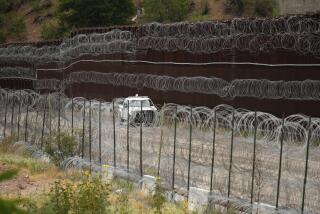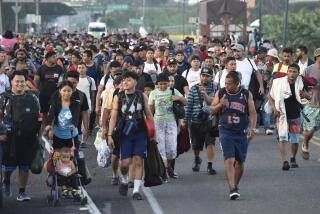INS Tightens Procedure for Students : Border: Children entering U.S. from Mexico to attend school will now be required to obtain visas.
In a decision that will affect thousands of Mexican students attending schools in San Diego and other border areas from California to Texas, U.S. immigration officials said Monday that authorities will begin in September to enforce a longstanding requirement that foreign pupils commuting from Mexico acquire visas.
Immigration inspectors have long allowed students to enter U.S. territory from Mexico by displaying so-called âborder crossing cards,â documents typically issued to frequent visitors who reside in Tijuana and other Mexican border communities.
However, the U.S. Immigration and Naturalization Service said Monday that it will begin enforcing the visa requirement, forcing thousands of commuting students residing in Mexico to apply for and acquire the visas before the new school year. Student visas have been legally mandated for years, but the requirement has not been enforced.
Roughly 1,000 to 4,000 students commute daily between Baja California and schools in San Diego and Imperial counties, according to an estimate by Rudy P. Murillo, an INS spokesman in San Diego.
The INS has sent letters to area schools informing them of the new enforcement strategy, Murillo said. But a representative of at least one affected school, Our Lady of Mt. Carmel in the border community of San Ysidro, said she was unaware of the new procedure.
âWhen did this happen?â asked Maria Jimenez, assistant principal at Our Lady of Mt. Carmel, where 60% of the 340 elementary and kindergarten students commute from Tijuana. âI hadnât heard anything about it.â
Immigration officials issued a press release outlining the revised procedures Monday, but authorities would not explain why they were changing tactics.
There was considerable conjecture that the service is attempting to crack down on Mexican pupils who give false U.S. addresses in order to gain entry to public schools. But the precise reason was not given, and it was unclear what prompted the action at this time.
The newly enforced visa requirement will mean that commuting students will have to go through an extensive visa application procedure. James Turnage, INS district director in San Diego, said he didnât know why agency officials in Washington had suddenly ordered field chiefs to enforce the visa requirement.
âWhen headquarters issues policy statements and directives for me, I donât have to go back and ask for the intellectual basis,â said Turnage, who oversees the INS apparatus in San Diego and Imperial counties. âI take directions.â
Added Murillo, the districtâs designated spokesman: âWe do not know what the rationale is.â
Virginia Kice, an INS spokeswoman in Los Angeles, said the agency preferred not to explain the move in detail. âWashington simply became aware that policy was not being enforced in some instances,â Kice explained after discussing the matter by telephone with a superior in Washington.
During the academic year, thousands of bookbag-toting school children--some wearing parochial school uniforms, others dressed in regular clothing--arrive almost daily at the San Ysidro port of entry and other border crossing from California to Texas en route to schools in the United States.
Most are Mexican citizens, but some are U.S.-born pupils who live with families in Mexico. Most attend elementary schools, but high school and college students also make the crossing.
The abundance of foreign students has drawn the ire of some critics, who have long complained that their guardians send them free of charge to U.S. public schools.
In San Diego, educators say that reports of such abuse are greatly exaggerated. Schools require parents to provide written evidence--such as copies of rent receipts and telephone bills--demonstrating family residence in the school districts.
âWeâre very strict about that,â said Nancy Montalvo, superintendent of the San Ysidro School District, which includes five border-area elementary schools and one middle school, instructing almost 4,000 pupils.
San Ysidro school officials discover about five or six cases a year in which students are found to be living in Tijuana, Montalvo said, adding, âIt happens, but itâs not a big problem.â
The U.S. consulate in Tijuana is gearing up to provide the visas in time for Septemberâs start of school, officials said.
To obtain student visas, the INS said, pupils in Mexico first must obtain certificates of enrollment from U.S. schools. Foreign students must then take the certificates--along with valid Mexican passports, evidence of tuition payments and their border-crossing cards--to U.S. consulates in Tijuana or other cities where they live.
More to Read
Sign up for Essential California
The most important California stories and recommendations in your inbox every morning.
You may occasionally receive promotional content from the Los Angeles Times.










